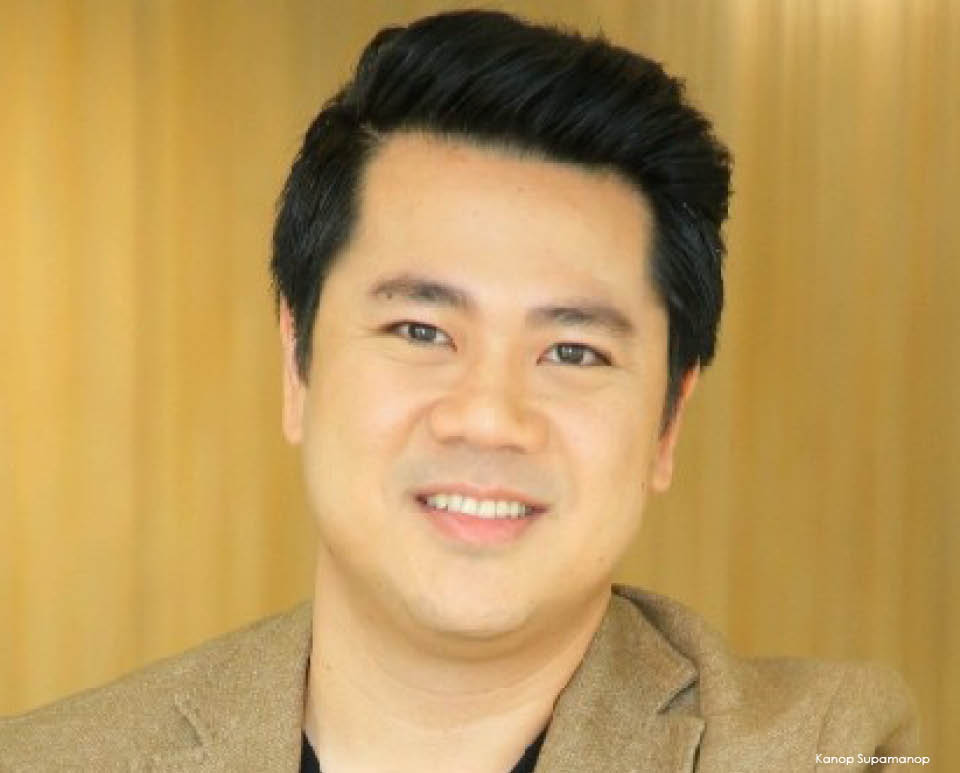
Line Thailand’s chief business officer, Kanop Supamanop, believes the way forward involves clear business objectives applied to every piece of content created or acquired, greater collaboration on various fronts, optimising relationships with smaller producers, and his belief that successful streaming platforms will find their own sweet spots.
In mid-2020, Thailand’s Line sold eight of its original drama series to Netflix – including Great Men Academy, Abandoned and Together With Me. For Line, the Netflix deal reinforced the quality of its Thai production, a particular point of pride. Three months later, in October, the Bangkok-based operation announced an alliance with Taiwan’s global LGBTQ streaming service GagaOOLala, putting a dozen GagaOOLala titles on Line TV in Thailand along with GagaOOLala’s first Thai-Taiwan boy love (BL) original, Call It What You Want, directed by Aam Anusorn Soisa-ngim (2 Moons 2, Present Still Perfect).
The latest deals are something of a quantum leap and speak to a bigger, broader, collaborative mindset with which Line Thailand enters the new year. The company’s chief content business officer, Kanop Supamanop, brings a spirit of collaboration to the streaming table because, he says, audiences are different and the regional exposure is welcome. In a wide-ranging interview, he also spoke about clearly defined business objectives; content decisions based not only on the ‘what’ but on the ‘why’; and the effective use of ever-expanding data-based insights.
Line TV is a pioneer of original production for streaming platforms in Thailand and remains in the lead with 78 originals in six years. What’s your approach to original production and how has this evolved? “The objective of the original content is to differentiate us from the others and create something interesting for our audience... and we need to serve exact business and/or marketing objectives. Over time, we have learned which genres fit what kind of audience. So in our sixth year, we have quite a good bible... maybe it’s not perfect, but at least we know which content serves which objectives. For this year through to next year, we still need to keep pushing and keep asking ourselves, ‘why do we need these originals? It’s not just about wanting it, but also why. It is very important, especially with the more compet...
Line Thailand’s chief business officer, Kanop Supamanop, believes the way forward involves clear business objectives applied to every piece of content created or acquired, greater collaboration on various fronts, optimising relationships with smaller producers, and his belief that successful streaming platforms will find their own sweet spots.
In mid-2020, Thailand’s Line sold eight of its original drama series to Netflix – including Great Men Academy, Abandoned and Together With Me. For Line, the Netflix deal reinforced the quality of its Thai production, a particular point of pride. Three months later, in October, the Bangkok-based operation announced an alliance with Taiwan’s global LGBTQ streaming service GagaOOLala, putting a dozen GagaOOLala titles on Line TV in Thailand along with GagaOOLala’s first Thai-Taiwan boy love (BL) original, Call It What You Want, directed by Aam Anusorn Soisa-ngim (2 Moons 2, Present Still Perfect).
The latest deals are something of a quantum leap and speak to a bigger, broader, collaborative mindset with which Line Thailand enters the new year. The company’s chief content business officer, Kanop Supamanop, brings a spirit of collaboration to the streaming table because, he says, audiences are different and the regional exposure is welcome. In a wide-ranging interview, he also spoke about clearly defined business objectives; content decisions based not only on the ‘what’ but on the ‘why’; and the effective use of ever-expanding data-based insights.
Line TV is a pioneer of original production for streaming platforms in Thailand and remains in the lead with 78 originals in six years. What’s your approach to original production and how has this evolved? “The objective of the original content is to differentiate us from the others and create something interesting for our audience... and we need to serve exact business and/or marketing objectives. Over time, we have learned which genres fit what kind of audience. So in our sixth year, we have quite a good bible... maybe it’s not perfect, but at least we know which content serves which objectives. For this year through to next year, we still need to keep pushing and keep asking ourselves, ‘why do we need these originals? It’s not just about wanting it, but also why. It is very important, especially with the more competitive situation, especially in the next year.”
Has your content strategy changed as a result of all the new competition in Thailand? “In terms of the competition, we need to keep an eye on our friends and we need to make sure that what we’re going to offer to our audience is interesting, appealing and distinct enough. We still focus on Thai content, of course, because we position ourselves as – and also believe and perceive from the market – that we are king of Thai content. Overall, Thai content is still majority consumed by Thais. When we talk about Thai content, we have room on our platform for all producers – whether they are big producers or not – if their content serves and answers our business objectives. The way we work is to empower and trust producers to work on their own, to make their content based on their own taste and style. That’s the key advantage of working with us. That’s why we have a variety of content; we have different tones and tastes of content to serve our audiences.”
How important is it for you to distribute Line content outside of Thailand? “Apart from the revenue, we’ll talk about the business ambitions of Line TV. We say clearly that we would like to be the content digitalisation engine for Thais.
Our objective is to help contribute to the Thai entertainment industry. When we have good digital content, and we believe that the quality is superior not just for Thai audiences, but that it also has high potential in the global market.
We need to make our ambition tangible by partnering with those who can help serve that ambition. We believe working with Netflix helps support our content producers, our Thai entertainment industry. It helps to create exposure of quality Thai content to the overseas market. We also need to build our footprint in other countries. That helps us benefit in terms of opening doors to any opportunities with potential partners in the future. And they might want to push their content into Line TV for Thai audiences as well. It benefits the audience, the industry, and us as well. That’s for the overseas market.
For the Thai market, we are the number one professional OTT in Thailand, but we need to admit that there are still some segments of audiences that we cannot tap into yet. So when we push our content onto other platforms where we believe there is potential, we will eventually acquire or gain those audiences into Line TV.
When we talk about Line TV original content, instead of just talking about the high quality and promoting it as worth watching, we increase the opportunity for our target audience to watch it. We expect the content to prove itself. Eventually, they will be our audience as well”.
Eight of your 78 originals went to Netflix. What about those particular eight – Instinct, Abandoned, Great Men Academy, The Collector, Together With Me, Together With Me: The Next Chapter, Social Syndrome and The Deadline – has particular international appeal? “First of all, the quality is not only Thai level, but Asian level, or even global. We believe, and it is proven, that the quality is superior. We believe those titles could lead global audiences to perceive that Thai content is better than they think. Not all of the eight series are produced by top producers. Some of them are produced by the small and medium ones. We need to leverage the exposure of this content and also leverage our small and medium partners as well. We selected the first phase of content based on quality, the difference in terms of tones and tastes of the content and the variety of the content partners. With all of these we can test together which kinds of genres are going to be well adopted by the global audience. So we can move on to the next phase more successfully.”
Line TV has been brave in pushing LGBTQ content, particularly with Boy Love (BL). What is your thinking in taking the lead in this way? “We started with an open mindset not limited by mass content, but also we are open to many genres and many content partners. It has performed well since a couple of years ago. Not because of the content, but also the platform and ecosystem that we support. When we talk about BL content, we start with how to build communities for those audiences. When we study our audiences, look at what content is popular and what creates a better experience for our audience is when we have communities talking together. When we talk about the communities, Line’s ecosystem can support them very well by enabling them to talk together, share via chatting, or even via the Line open chat to talk into our ecosystem. In previous years, we focused on the mobile screen. That served us well during that time because BL content, I would say, is not comfortable for everyone to watch on the big screen. Mobile works well for the user preference, and that’s why BL content performs well on OTT like us. And then there’s the support of the ecosystem that helps them to enjoy content together with similar audiences. All those things help us drive our position in Thai society.
“When we talk about BL content becoming mainstream, we need to define mainstream. I’m not talking about mass or that everyone watches, but about bigger and bigger audience in the specific segment. For example, the major audience for BL content is female aged 20 to 30-something. We are seeing bigger and bigger numbers of active users in this segment for BL content.
“During the Covid lockdown, we saw a lot of growth in other segments as well. For example, there was a lot of growth in consumption among females over 55 years old. It helped prove that BL content is appealing to not only a niche segment, but a bigger and bigger audience. We see that from the stats of active users.
“Also with the trend in social media, in mainstream news, and in TV ratings. Some BL content also aired on TV and performed well. We see that some major TV channels starting to produce BL content. This is evidence of BL content’s growing popularity.
“Most important for us is monetisation. Advertisers used to be doubtful about advertising on BL content. But this year, there’s huge demand from clients and agencies, so it proves people are adopting to this kind of content.”
Thailand has always been a creative and a content production hub. Streaming has placed a much higher demand on that. Is the domestic production industry able to cope with this demand. If not, what would you like to see? “Demand for Thai content exceeds supply. But I believe the market will eventually optimise itself in a few ways. The first is collaborations between OTT platforms. We have started to see OTT platforms that do not have duplicate audience segments co-invest in original content, share or sub-license content. This helps to relieve the shortage on the supply side, and also helps each OTT to minimise costs while still taking maximum advantage of monetisation opportunities. We will see this more and more in the future.
Secondly, I think it is best for the industry to make bigger and bigger room for small and medium content producers. We are starting to see many OTTs, including Line TV, not only focus on major producers, but working with small and medium producers as well. When we have clear business objectives, there may be no need for the big producers; small and medium producers can serve that well. This will help everyone in the industry to enjoy [the current situation.”
What do you see as the biggest content challenges? “The first is higher and higher competition. This not only impacts the cost of production but also the supply... We optimise ourselves with more collaborations and utilise resources and supply in the market as much as possible.
“When we talk about higher demand for Thai content, the first thing we need to talk about is price inflation on acquiring content. This also leads to a bigger opportunity for small and medium producers.
“All OTTs will find their sweet spot, which kinds of genre, which kinds of content categories they want to stand for, including Line TV. Eventually not everyone will compete in the same domain. We will all shift away from each other and find our own standpoints.
“We have strong belief in Thai content, and get a good perception from the market. But we are not limited to that. We also talk to many partners, explore many genres, for example animation, which could serve our business objective and also help provide users with a diverse range of content. Ultimately, everyone will find their own standpoint... stand for something.”
Published in ContentAsia's December 2020 magazine























